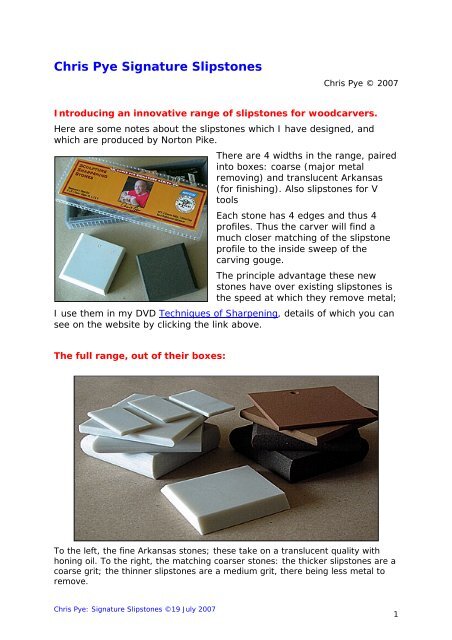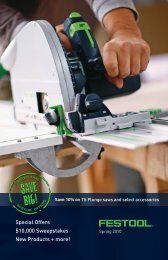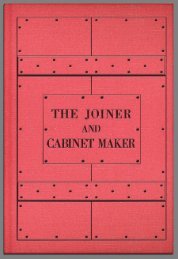Chris Pye Signature Slipstones - Tools for Working Wood
Chris Pye Signature Slipstones - Tools for Working Wood
Chris Pye Signature Slipstones - Tools for Working Wood
You also want an ePaper? Increase the reach of your titles
YUMPU automatically turns print PDFs into web optimized ePapers that Google loves.
<strong>Chris</strong> <strong>Pye</strong> <strong>Signature</strong> <strong>Slipstones</strong><br />
<strong>Chris</strong> <strong>Pye</strong>: <strong>Signature</strong> <strong>Slipstones</strong> ©19 July 2007<br />
<strong>Chris</strong> <strong>Pye</strong> © 2007<br />
Introducing an innovative range of slipstones <strong>for</strong> woodcarvers.<br />
Here are some notes about the slipstones which I have designed, and<br />
which are produced by Norton Pike.<br />
There are 4 widths in the range, paired<br />
into boxes: coarse (major metal<br />
removing) and translucent Arkansas<br />
(<strong>for</strong> finishing). Also slipstones <strong>for</strong> V<br />
tools<br />
Each stone has 4 edges and thus 4<br />
profiles. Thus the carver will find a<br />
much closer matching of the slipstone<br />
profile to the inside sweep of the<br />
carving gouge.<br />
The principle advantage these new<br />
stones have over existing slipstones is<br />
the speed at which they remove metal;<br />
I use them in my DVD Techniques of Sharpening, details of which you can<br />
see on the website by clicking the link above.<br />
The full range, out of their boxes:<br />
To the left, the fine Arkansas stones; these take on a translucent quality with<br />
honing oil. To the right, the matching coarser stones: the thicker slipstones are a<br />
coarse grit; the thinner slipstones are a medium grit, there being less metal to<br />
remove.<br />
1
What are slipstones? What are they used <strong>for</strong>?<br />
Together with benchstones, slipstones are used to correctly sharpen<br />
woodcarving gouges.<br />
<strong>Wood</strong>carvers use the benchstone to<br />
work on the outside bevel of the<br />
carving gouge, which must be<br />
sharpened to the correct angle (15-<br />
20°).<br />
Shown here is a translucent Arkansas<br />
benchstone, also to be found in the<br />
range that I am putting my name to.<br />
(Meaning I am on their case about<br />
giving woodcarvers the best and most appropriate quality.)<br />
<strong>Slipstones</strong> either create the inside<br />
bevel of their carving gouges (5-10°)<br />
or remove any 'burr' on the inside <strong>for</strong> a<br />
final keen edge of a gouge.<br />
Both slipstones and benchstones are<br />
available in coarse or fine (translucent<br />
Arkansas) grits: The coarse stones<br />
remove metal quickly and thus <strong>for</strong>m<br />
the overall profile of the bevels and<br />
cutting edge. The fine stones conclude<br />
the process, leaving a keen edge.<br />
Why an inside bevel?<br />
Note: Carvers have differing styles of working and thus tool requirements. I<br />
always recommend that carvers compare gouges with and without the inside<br />
bevel and make their own minds up, convincing themselves of the advantages of<br />
having an inside bevel.<br />
The inside bevel has 3 principle functions:<br />
• The inside bevel allows the<br />
gouge to be used 'upside<br />
down'<br />
Carving tools work in a very<br />
different way to carpentry chisels.<br />
When a carpentry chisel cuts into<br />
the wood it 'self-jigs': the blade<br />
rests on the facet it has just made<br />
to <strong>for</strong>m a flat face <strong>for</strong> the blade to<br />
run along precisely.<br />
<strong>Chris</strong> <strong>Pye</strong>: <strong>Signature</strong> <strong>Slipstones</strong> ©19 July 2007<br />
2
The chisel cannot exit the cut back to the surface without 'chattering'<br />
because there is nothing <strong>for</strong> the cutting edge to pivot on.<br />
To exit the cut, the carpentry<br />
chisel must be turned beveldown<br />
so that the cutting edge<br />
can now pivot on the 'heel'<br />
(where bevel meets blade<br />
proper).<br />
In contrast to carpentry chisels,<br />
gouges are principally used<br />
with the main, outer bevel to<br />
the wood—in other words, like the carpentry chisel turned over, beveldown.<br />
The action of the gouge is more<br />
one of scooping; truly flat faces<br />
are rarely needed. Without any<br />
inside bevel whatsoever—the<br />
state of all new carving tools—a<br />
gouge used upside down will jig<br />
itself into the wood just like a<br />
carpentry chisel; the carver will<br />
have the same problems of<br />
'chatter' exiting when they try to<br />
scoop out of the wood.<br />
With an inside bevel, a gouge can be com<strong>for</strong>tably used upside down,<br />
losing that tendency to jig and dig in that a flat face to the tool gives. The<br />
versatility of the tool is thus greatly increased with a carver matching the<br />
profile of the gouge to the roundness of the wood surface when shaping<br />
convex surfaces.<br />
• The inside bevel strengthens the cutting edge.<br />
Carvers need a low angle of presentation to the wood (a low 'cutting<br />
angle')—an outside bevel angle of somewhere around (15-20°)—<strong>for</strong><br />
maximum control and efficient use of ef<strong>for</strong>t. This angle is relatively weak<br />
when considered as a wedge of metal being pushed into the wood.<br />
<strong>Chris</strong> <strong>Pye</strong>: <strong>Signature</strong> <strong>Slipstones</strong> ©19 July 2007<br />
3
By adding a short inside bevel of 5-10°, the overall angle of the 'wedge of<br />
metal' is increased to (20-30°), much tougher. The cutting edge is<br />
thrown towards the middle of the metal, buttressed on both sides.<br />
• The inside bevel lifts the shaving out of the gouge<br />
Shavings and chips tend to bind against the walls of deep and U-shaped<br />
gouges as they run up the 'cannel' (the inner trough). An inner bevel<br />
eases the shaving out of the gouge by breaking and lifting the chip.<br />
Do all carving tools have inside bevels?<br />
The general principle is that the more the gouge is used upside down, the<br />
more inside bevel is needed. (There are a few exceptions to this, such as<br />
pea or bead mouldings where the 'self-jigging' action of the edge is a<br />
benefit to cutting the extremely tight curve required).<br />
The flatter the gouge, the more inside bevel it will have and the more the<br />
inside bevel is an advantage. Deep gouges have a short inside bevel. Bent<br />
gouges and V tools have none.<br />
Carvers experiment and find the right amount of inside bevel that suits<br />
them, their tools and their style of carving.<br />
Why don't gouges come with inside bevels already present?<br />
Today, many carvers are self taught and assume the manufacturers give<br />
them correctly sharpened tools. However, 'ready sharpened' gouges are a<br />
modern phenomenon. In the past gouges were bought 'set but not<br />
sharpened', with the outer bevel roughly ground to shape.<br />
Carvers sharpened their own tools in the way that that suited them.<br />
Carvers vary in their approach to carving and thus the way they like their<br />
carving tools configured (and this configuration does alter somewhat with<br />
hardness of wood etc).<br />
New carving gouges may be 'sharp' but not cut well: the outer bevel all<br />
too commonly has too high a cutting angle, and the gouge cannot be used<br />
upside down so well <strong>for</strong> lack of the inside bevel. These features need to be<br />
corrected and carving tools 'commissioned' be<strong>for</strong>e arriving on the bench.<br />
Carving tool manufacturers sell carving tools. Adding an inside bevel is an<br />
extra step and thus manufacturing cost when they can rightfully expect<br />
carvers to sharpen their tools in the way that we would expect a violinist<br />
to tune their violin.<br />
<strong>Chris</strong> <strong>Pye</strong>: <strong>Signature</strong> <strong>Slipstones</strong> ©19 July 2007<br />
4
What is special about these slipstones?<br />
There has always been very<br />
limited choice in commercially<br />
available slipstones, invariably<br />
wedge-shaped and with a<br />
single cutting surface that<br />
matches the sweep (crosssection<br />
profile) of precious few<br />
gouges. These slipstones were<br />
originally made with gunsmiths<br />
and similar trades in mind, not<br />
carvers.<br />
Traditionally, woodcarvers<br />
acquired their sharpening<br />
stones over years from other carvers from whom they learnt, or inheriting<br />
from fellow carvers, or sharing within architectural workshops. The<br />
collection of slipstones, fashioned over many years of use would vary in<br />
size and contour, and would<br />
more closely match the<br />
sweep of gouges.<br />
The closer the profile of the<br />
slipstone matches the sweep<br />
of the gouge, the more<br />
abrading surface is in contact<br />
and the quicker and truer is<br />
the inner bevel <strong>for</strong>med or the<br />
edge sharpened.<br />
The main advantage is that each stone<br />
gives a choice of 4 cutting edges, and<br />
there is a wide choice of stones: coarse<br />
and fine, and from small detail gouges to<br />
large sculptural one. Thus carvers can<br />
match the sweep of their gouges to that of<br />
the slipstones, if not perfectly then closely.<br />
This means that the time to create or<br />
sharpen on the inside bevel is enormously<br />
decreased compared with what has been<br />
possible with currently available slipstones.<br />
<strong>Chris</strong> <strong>Pye</strong>: <strong>Signature</strong> <strong>Slipstones</strong> ©19 July 2007<br />
The signature slipstones<br />
are the first designed by a<br />
carver specifically <strong>for</strong><br />
woodcarvers.<br />
5
Note: Because there is a huge number or sweeps (the radii of the arc of<br />
the gouge edge) and widths, it is impossible <strong>for</strong> these slipstones to fit all<br />
of them perfectly. However, where they don't they should fit a lot closer<br />
than with previously available slipstones. Also, <strong>for</strong> the cost of the<br />
slipstone, the carver gets 4 profiles, rather than one.<br />
You can change the profile of these slipstones using a coarse benchstone<br />
or flattening stone – also available from Norton Pike.<br />
How do you use them?<br />
The carver matches the profile of one slipstone edge to the sweep of the<br />
gouge as closely as possible then (with<br />
oil) rubs the stone back and <strong>for</strong>th in<br />
cannel at a tight angle (5-10°),<br />
inspecting the metal surface<br />
continually to monitor the abrasion.<br />
Sharpening woodcarving tools and<br />
using slipstones is fully described in my<br />
books, in particular '<strong>Wood</strong>carving<br />
<strong>Tools</strong>, Materials and Equipment' vol. 1<br />
and in my DVD Techniques of<br />
Sharpening.<br />
Where do I get them?<br />
• UK:<br />
Classic Hand <strong>Tools</strong><br />
(web: www.classichandtools.com<br />
• North America:<br />
Rob Cosman<br />
(web: www.robcosman.com)<br />
<strong>Tools</strong> <strong>for</strong> <strong>Working</strong> <strong>Wood</strong><br />
(web: www.tools<strong>for</strong>workingwood.com)<br />
Can I see them in action?<br />
Yes, indeed. I use them in my DVD Techniques of Sharpening, details of<br />
which you can see on the website by clicking the link above.<br />
<strong>Chris</strong> <strong>Pye</strong>: <strong>Signature</strong> <strong>Slipstones</strong> ©19 July 2007<br />
6
Power v Hand Sharpening<br />
There is no moral high ground in sharpening by hand, and power<br />
sharpening devices are essential to the busy carver to save time.<br />
I see these slipstones are simply a part of the carver's general sharpening<br />
'kit' and will find uses no matter what approach a carver takes.<br />
• Getting the correct and exact qualities in a carving tool to make it<br />
carve as efficiently as possible is a skill. Honing machines are very<br />
fast and used incorrectly quickly give poor profiles (lost corners,<br />
rounded bevels and high cutting angles) or overheating metal.<br />
• Sharpening by hand is a safer more considered way of working and<br />
I always suggest that beginners learn this skill slowly first—by<br />
hand—and only when they know exactly what to look <strong>for</strong> in a<br />
correctly sharpened gouge and how to achieve it, introduce power<br />
assistance to speed the process up.<br />
• There are some gouges that it is very difficult if not impossible to<br />
sharpen on a machine, either because of their smallness or shape.<br />
• <strong>Slipstones</strong> are also useful <strong>for</strong> exact touching up of edges.<br />
• Very large gouges can have their inner bevels ground in; the<br />
appropriate slipstone is used to clean and unify the abraded<br />
surface.<br />
• You can take slipstones with you where sharpening machines would<br />
be inappropriate or unavailable.<br />
• There are many carvers who actually don't like honing machines<br />
and grinders. They find hand sharpening more pleasant, more in<br />
keeping with the speed at which they work and even 'meditative'.<br />
• You also have to ask: where does all that abrasive material flung<br />
out by these high speed honing machines ends up? In the air, <strong>for</strong><br />
the carver to breathe.<br />
<strong>Chris</strong> <strong>Pye</strong>: <strong>Signature</strong> <strong>Slipstones</strong> ©19 July 2007<br />
7













